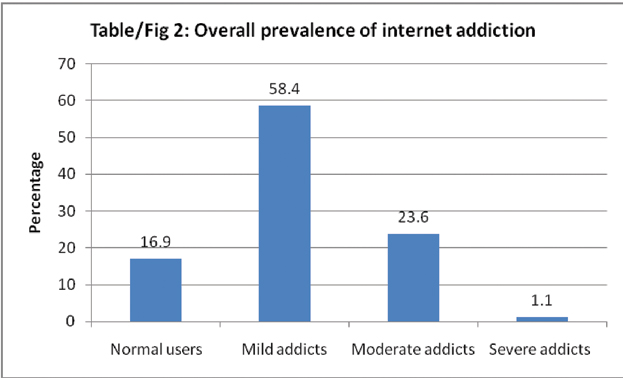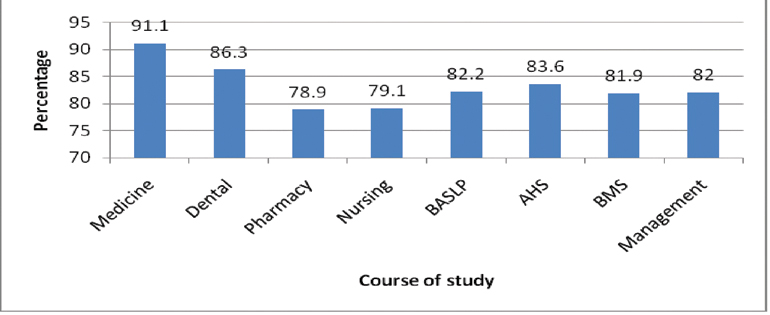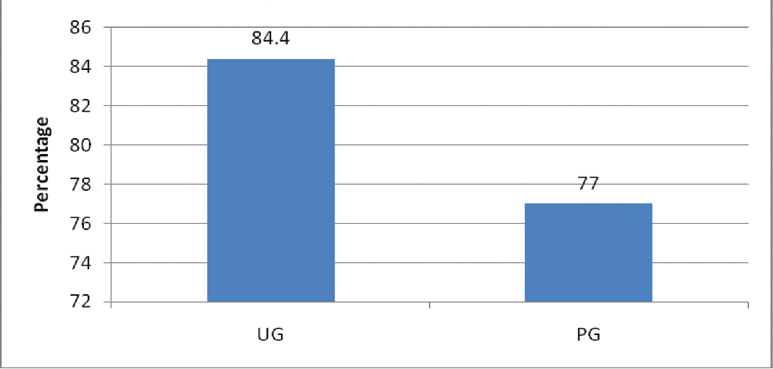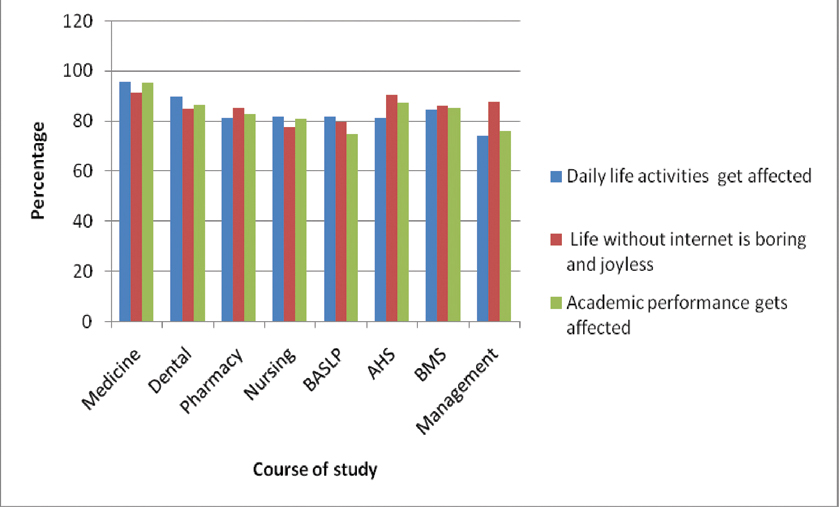Internet addiction is ‘an individual’s inability to control his or her internet use, which causes various difficulties in personal life [2]. Internet dependence is most vulnerable among College students, more than most other segments of the society. This can be attributed to several factors like availability of time, ease of use, unlimited access to the internet, limited or no parental supervision. As some specialties are dependent on internet for projects and other purposes, it plays as a major factor. All of these make internet overuse a significant cause of concern for parents and faculty [4].
Hence, excessive use of internet adversely affects ones physical, mental and social health along with academic performance [2]. Physical problems include backache, head ache, sleep disturbances, weight gain and blurred vision. Mental problems include depression, low self-esteem and fear that life without internet would be empty, boring and joyless [5]. Academic problems include missing classes, significant fall in grades and reduction in study habits and poor interest in extracurricular activities [2]. Previous studies say online stay above five hours a day may be followed by increased risk of addiction [6].
All these problems due to addictive use of internet arouse attention among researchers all over the world [5]. India is ranked as fourth highest users of internet among all other countries [7]. Sharma A, et al., reported that physiotherapy students had higher prevalence of internet addiction among all other specialties [8]. As internet usage and availability is increased and this has its impacts in subjects who are on their learning curve with its effects on their academic performance this study was performed. The present study aimed at determining the prevalence of internet addiction among undergraduate and postgraduate medical and paramedical students.
Materials and Methods
This questionnaire based cross-sectional study was carried out among 1011 medical and paramedical undergraduate and postgraduate students of Sri Ramachandra University, Chennai. Ethical clearance was obtained from Institutional Ethical Committee. Verbal consent was obtained from the participants who were present on the day of study. The study was conducted in 2016 for a period of seven months from May-November. The samples were from eight different specialties which include undergraduate and postgraduate students from Medical, Dental, Pharmacy, Nursing, Speech, Audiology and Language therapy (Speech Therapy), Allied Health Sciences (AHS), Biomedical Sciences (BMS) and Management courses.
A questionnaire consisting of two components; basic demographic information of the participants and Modified Young’s Internet Addiction Test (IAT) was used to gather data. The IAT is a questionnaire which has 20 items with a scoring of 0 to 5 for each question with a total maximum score of 100 [1]. Based on overall scoring subjects were classified into normal users (<20), average users (20-49), moderate users (50-79) and severe users (80-100). The normal users were categorized as non-addicts and mild, moderate and severe users were categorized as addicts.
The questionnaire was distributed to each candidate in person and they were given half an hour time to fill it and were collected back. Those who were not willing to participate and those who were absent were excluded from the study. Inclusion criteria included all candidates who had access to internet and those who used internet [APPENDIX 1].
The calculation of sample size was based on a study done by Krishnamurthy S et al., [4]. The probability of type I error was inferred at 5% and the probability of type II error was inferred at 20%, hence power of the study = 80%. The sample size for this study was calculated using the formula (Zα+Zβ)2 x pq/α2 and the sample size was estimated to be 700. The sample size for the present study was increased to 1011.
Statistical Analysis
Descriptive statistics was calculated in terms of frequency and percentage. Inferential statistics was calculated using Chi-square test.
Results
A total of 1011 university students were assessed with age range of 17-26 years. The sociodemographic characteristics of the study participants are shown below [Table/Fig-1].
Sociodemographic characteristics of study participants.
| SOCIODEMOGRAPHICVARIABLES | FREQUENCY | PERCENTAGE | TOTAL |
|---|
| GENDER MALE FEMALE | 296715 | 2971 | 1011 |
| Courses Medical | 123 | 12 | 1011 |
| Dental | 131 | 13 |
| Pharmacy | 128 | 13 |
| Nursing | 134 | 13 |
| Speech Therapy | 135 | 13 |
| AHS | 122 | 12 |
| BMS | 127 | 13 |
| Management | 111 | 11 |
| Graduates Undergraduates Postgraduates | 828183 | 8218 | 1011 |
| Residence Hostler Day Scholar | 485526 | 4852 | 1011 |
| Year of Study 1st 2nd 3rd 4th 5th | 1855072494327 | 18502543 | 1011 |
According to the findings, most of the students were mild internet addicts 590 (58.40%) followed by moderate addicts 239 (23.60%), normal users 171 (16.90%) and severe addicts 11(1.10%) [Table/Fig-2].
Overall prevalence of internet addiction.

On analysing the questionnaires, it was found that internet addicts were higher in males 252 (85.20%) than in females 588 (82.20%).
Prevalence of internet addiction was outnumbered by medical 112 (91.10%) students among all the other medical and paramedical specialties.
Majority of non-addicts were found in pharmacy 27 (21.10%) students when comparing with all other specialties [Table/Fig-3].
Prevalence of internet addiction based on course of study.

When assessing the undergraduates and postgraduates, approximately 699 (84.40%) of undergraduates were addicted to internet and it was even more surprising to know that majority of postgraduates 42(23%) were non-addicts [Table/Fig-4].
Prevalence of internet addiction among undergraduates and postgraduates.

A maximum number of medical students felt that their daily life activities 118 (95.90%) and academic performance get affected 117 (95.10%) because of internet and also feel that life without internet would be empty, boring and joyless 112 (91.10%) than all other medical and paramedical specialties [Table/Fig-5].
Effects of Internet Addication.

Majority of males feel that their daily life activities 256 (86.50%) and academic performance get affected 252 (85.10%) because of internet and also feel that life without internet would be boring 250 (84.50%) in comparison with females [Table/Fig-6].
Comparison between behavioural aspects of internet users by gender.
| Characteristics | Males | Females | p-value |
|---|
| Yes | No | Yes | No |
|---|
| Fear that life without internet would be empty, boring and joyless. | 84.50% | 15.50% | 85.20% | 14.80% | 0.04 |
| Daily life activities get affected because of internet. | 86.50% | 13.50% | 82.50% | 17.50% | 0.05 |
| Academic performance gets affected because of internet. | 85.10% | 14.90% | 82.70% | 17.30% | 0.1 |
Candidates residing in hostel 406 (83.7%) were more addicted than the day scholars 434 (82.5%).
Students in the fourth 40 (93%) and fifth year 24 (88.90%) are more addicted than rest of the years.
All the above results in this study were statistically significant with a (p-value <0.05) except for two sociodemographic characteristics which are year of study, residence and effect of internet on academic performances within genders.
Discussion
This study was done to understand the extent of internet addiction among medical and paramedical students. The Modified Young’s IAT for measuring internet addiction was used. On analysis, we found that out of 1011 samples, 16.9% were normal users of internet, 58.4% were mild addicts, 23.6% were moderate addicts and 1.1% was severe addicts. Majority of the students were mild addicts. Similar results were reported in a study by Srijampana VV et al., showing 23.2% normal users, 64.4% mild addicts, 11.8% moderate addicts and 0.4% severe addicts [3]. Studies done by Sharma A et al., Dhok RS, et al., and Hashemian A, et al., on medical professionals showed that there were higher number of normal users ranging from 53-57% [8-10]. This shows there is a drastic decrease in number of normal users in comparison to the present study.
In a study done in Mangalore by Chathoth VM et al., on medical professionals there were no severe addicts whereas in present study there are 1.10% severe addicts [5]. This difference in prevalence rates shows internet addiction is gradually increasing and the probable reason might be due to advanced technologies available like smart phones, digital watches etc.
In a study done in Persian population severe addiction was 13% which was very much higher than current study in Indian population which is 1.10% [11]. This huge variability in prevalence rates could be due to heterogeneity of population and many other reasons.
One of the objectives of this study was to find the effect of gender on internet addiction scores. We observed that males were significantly at higher risk of internet addiction when compared with females. This is consistent with findings of Hamissi J et al., and Marahatta SB et al., in their study in Iran and Nepal on medical students and health science students respectively [12,13].
We found out that higher number of addicts reside in hostel. This is in accordance with similar reports by Mashaei et al., in their study. This shows that internet addiction can be variable with the support of family members [14].
Among the eight different medical and paramedical specialties, undergraduate medical students were highly addicted to internet than other specialties. The reason behind this might be that they are children from a higher socioeconomic status. Hashemian A et al., also reported a similar prevalence in their study [10].
When comparing the undergraduates and postgraduates, undergraduates were addicted to internet in the current study. This might be due to their feel of sudden freedom from school to college and also due to less burden and stress in undergraduate life. No studies are done comparing undergraduates and postgraduates in the existing literature.
Regarding the impact of year of study on internet, internet addiction is highly significant in the fourth and fifth year in the present research and this may be due to the amount of time available and stress of studies reduced during internship. This report was in accordance with study by Capetillo-Ventura N et al., [15]. A similar study was conducted by Krishnamurthy S et al., which showed that students in initial years of course were addicted more than the other years [4]. It may be as a result of recent completion of schooling and less parental supervision.
Majority of males feel that life without internet is boring. Similar results were obtained in a study done by Naffise Mashaei et al., [14]. They also feel their academic and daily life activities are affected due to internet. This shows internet dependency in the current generation. Out of all the specialties medical students feel that life without internet is empty, boring and joyless and also feel that their academic and daily life activities are affected due to internet when compared to the other students.
Limitation
The main limitation of this study is that the data collected is a self-report of the students and hence, can be systematically biased. They would not like to be called an ‘addict’ and this might have prevented them from revealing the real scenario.
Conclusion
Internet addiction has become an emerging problem among the professional students, which has educational, physical and mental impact on student’s life. So, it is necessary to understand the importance of prevention of internet addiction, which is essential for promoting safe and healthy use of internet. It is necessary to create awareness among the students to improve their quality of life by avoiding addictive use of internet.